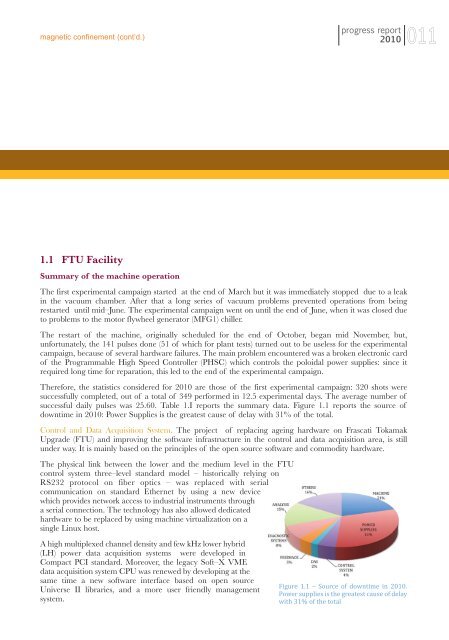Prime pagine RA2010FUS:Copia di Layout 1 - ENEA - Fusione
Prime pagine RA2010FUS:Copia di Layout 1 - ENEA - Fusione
Prime pagine RA2010FUS:Copia di Layout 1 - ENEA - Fusione
Create successful ePaper yourself
Turn your PDF publications into a flip-book with our unique Google optimized e-Paper software.
magnetic confinement (cont’d.)<br />
progress report<br />
2010<br />
011<br />
1.1 FTU Facility<br />
Summary of the machine operation<br />
The first experimental campaign started at the end of March but it was imme<strong>di</strong>ately stopped due to a leak<br />
in the vacuum chamber. After that a long series of vacuum problems prevented operations from being<br />
restarted until mid–June. The experimental campaign went on until the end of June, when it was closed due<br />
to problems to the motor flywheel generator (MFG1) chiller.<br />
The restart of the machine, originally scheduled for the end of October, began mid November, but,<br />
unfortunately, the 141 pulses done (51 of which for plant tests) turned out to be useless for the experimental<br />
campaign, because of several hardware failures. The main problem encountered was a broken electronic card<br />
of the Programmable High Speed Controller (PHSC) which controls the poloidal power supplies: since it<br />
required long time for reparation, this led to the end of the experimental campaign.<br />
Therefore, the statistics considered for 2010 are those of the first experimental campaign: 320 shots were<br />
successfully completed, out of a total of 349 performed in 12.5 experimental days. The average number of<br />
successful daily pulses was 25.60. Table 1.I reports the summary data. Figure 1.1 reports the source of<br />
downtime in 2010: Power Supplies is the greatest cause of delay with 31% of the total.<br />
Control and Data Acquisition System. The project of replacing ageing hardware on Frascati Tokamak<br />
Upgrade (FTU) and improving the software infrastructure in the control and data acquisition area, is still<br />
under way. It is mainly based on the principles of the open source software and commo<strong>di</strong>ty hardware.<br />
The physical link between the lower and the me<strong>di</strong>um level in the FTU<br />
control system three–level standard model – historically relying on<br />
RS232 protocol on fiber optics – was replaced with serial<br />
communication on standard Ethernet by using a new device<br />
which provides network access to industrial instruments through<br />
a serial connection. The technology has also allowed de<strong>di</strong>cated<br />
hardware to be replaced by using machine virtualization on a<br />
single Linux host.<br />
A high multiplexed channel density and few kHz lower hybrid<br />
(LH) power data acquisition systems were developed in<br />
Compact PCI standard. Moreover, the legacy Soft–X VME<br />
data acquisition system CPU was renewed by developing at the<br />
same time a new software interface based on open source<br />
Universe II libraries, and a more user friendly management<br />
system.<br />
Figure 1.1 – Source of downtime in 2010.<br />
Power supplies is the greatest cause of delay<br />
with 31% of the total













